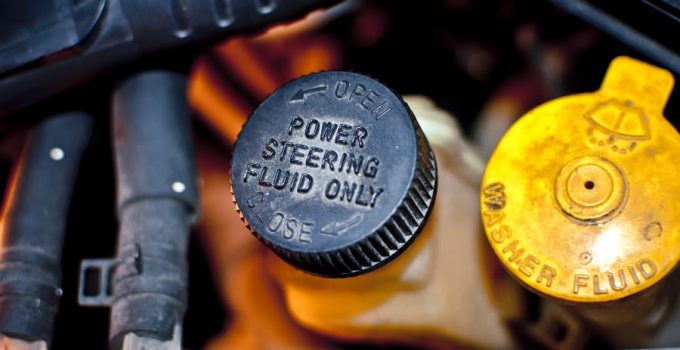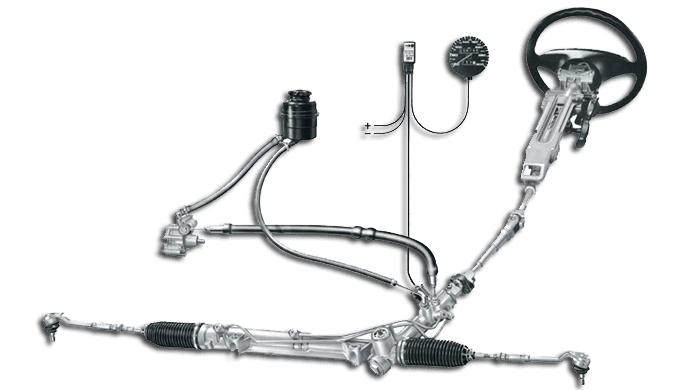
The lifespan of power steering systems is typically the same as the lifespan of vehicles that they own. However, this is only the case if there are no servo oil leaks in the system. Using inferior oil or replacing the fluid too late are the most common reasons for power steering failure. Read our article to learn how to avoid mistakes when selecting and changing hydraulic fluid.

Contents
The causes of deterioration of the hydraulic fluid of a power steering
Intense loads on the power steering and a sharp drop in pressure in the system lead to premature deterioration in oil quality. Our experts can identify four main causes of oil deterioration:
- Overheating;
- Excessive use of power steering (aggressive driving style);
- The integrity of the system is corrupted;
- The fluid is unsuitable according to the technical conditions of the car.
Bypass valves are used in modern cars to protect the system components from damage.
color change, oil becomes dark;
Appearance of a burning smell;
< i class="as-icon as-icon--circle as-icon--info" style="background-color: #fffff"> Increase in steering wheel resistance;
Abnormal noise when turning the steering wheel;
Liquid leak.
You must also change the fluid when a repair is made to the pump or any other power steering component. The use of oil that has lost its original properties or is unsuitable can damage the pump or the coils and lead to premature wear of the sealing elements. In some vehicles such as the Toyota Corolla, the Subaru Impreza and almost all Volkswagen vehicles, it is not possible to replace the sealing elements. If these have deteriorated, then it will be necessary to install a new power steering system.
How to select power-steering fluid
There are different main types of fluids:
1. Minerals. These include refined petroleum fractions and additives to improve the working properties of the oilṣ. The main advantage of mineral fluids, in addition to the price, is that they do not have an aggressive effect on the rubber elements. But it has a short lifetime and prone to foaming
2. Semi-synthetic. Their composition includes both mineral and synthetic substances. Its advantages are low viscosity, resistance to foaming and good lubricity. But semi-synthetic fluids have a destructive effect on the rubber elements of the power steering.
3. Synthetic. Their composition mostly includes polyhydric alcohol, polyester and a small amount of partially refined petroleum. In order to reduce the destructive influence on the rubber seals there are special additives that are mixed with the synthetic oil composition. Synthetic oils, although more expensive, have excellent performance characteristics: resistance to foaming, the ability to work in extreme temperatures and a long service life.
The power steering fluid usually has information about the standards to be met and in which makes of car it is used on the packaging.
Hydraulic fluid varies not only in composition and performance characteristics, but also in colour.
The most common are the following:
1. Red. These are manufactured to GM Automotive Group standards and are also known as Dexron. They are manufactured by the company itself and also by licensed manufacturers. These fluids are used in Toyota, Kia, Mazda and GM cars.
2.Yellow. They are mainly intended for Mercedes-Benz vehicles. They are developed by Daimler, but also produced by other licensed manufacturers.
3.Green. These are manufactured by the German company Pentosin. They are mainly used in vehicles from Volkswagen, Ford, Bentley, BMW and Volvo, but also in vehicles from the Daimler Group.
However, it is a mistake to choose power steering oil only by color. Color does not always indicate composition. For example, the Dexron fluids can be either mineral or synthetic, although they are still the same color. Strong mixing of mineral, synthetic and semi-synthetic fluids is prohibited.

The automatic change of the power-assisted steering fluid
Anyone can change the power steering fluid themselves. This process is simple and will only take 30 minutes. You will need a large syringe, a container for the old fluid, and protective gloves for this procedure.
Hold on Follow the sequence of steps below:
- Raise and secure the front of the vehicle with a jack.
- Using a syringe and pump, release the old Liquid out of the tank.
- Disconnect the return hose and place it in a prepared container. Then drain the oil.
- Pour the new fluid into the system.
- Turn the steering wheel until it stops a few times.
- If drain the old fluid, then pour the new fluid up to the mark located on the surface of the power steering fluid tank or on the dipstick mounted in the reservoir cap. Top up with oil until new fluid flows from the hose.
- Fit the hose in place, start the engine and turn the steering wheel in either direction.
- Refill the liquid up to the mark.
Conclusion
Only buy quality oil, always consider the technical requirements of your car, do not neglect the recommendations for changing the oil. A calm driving style, timely fluid replacement and following the rules will ensure long and reliable performance of the power steering.

